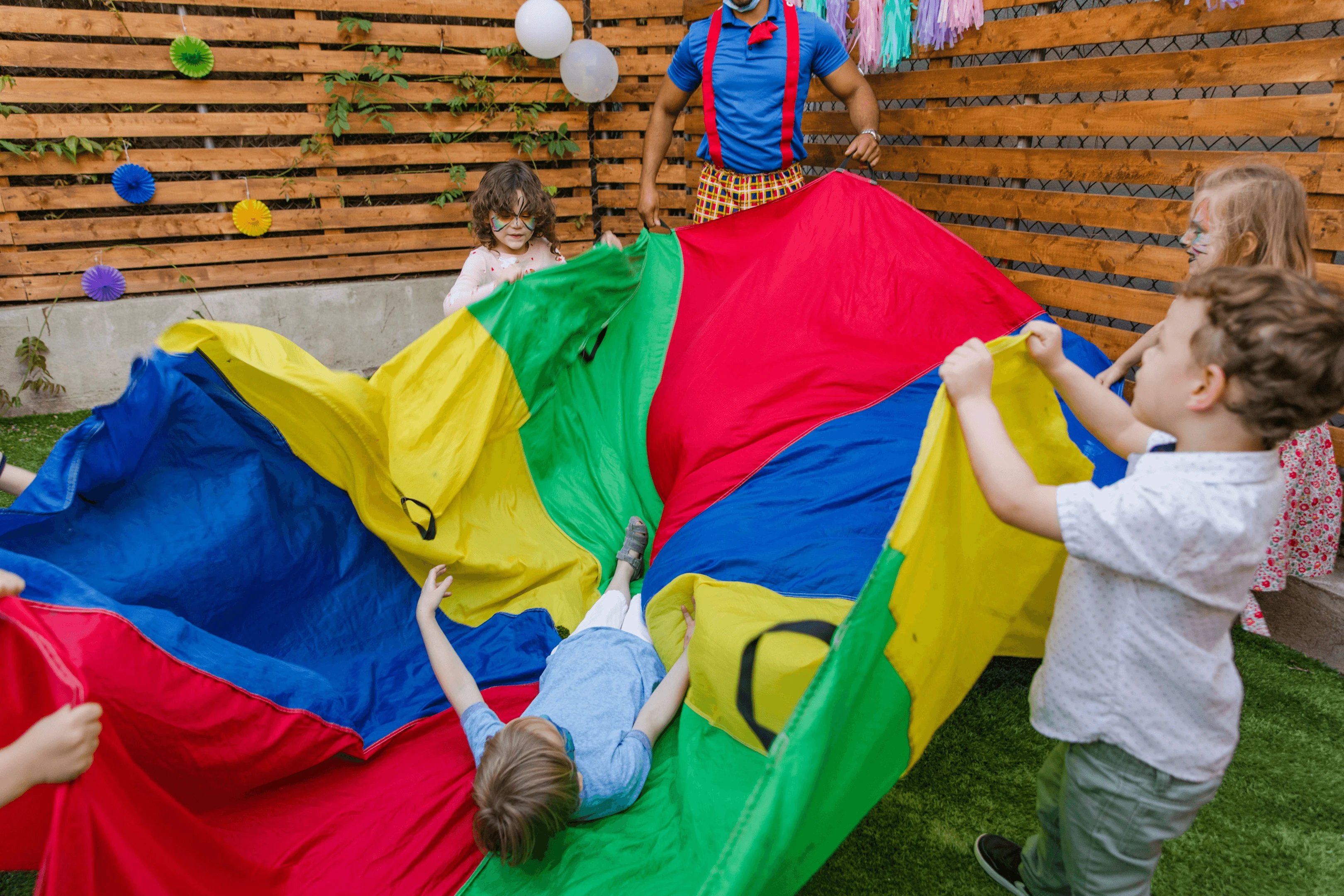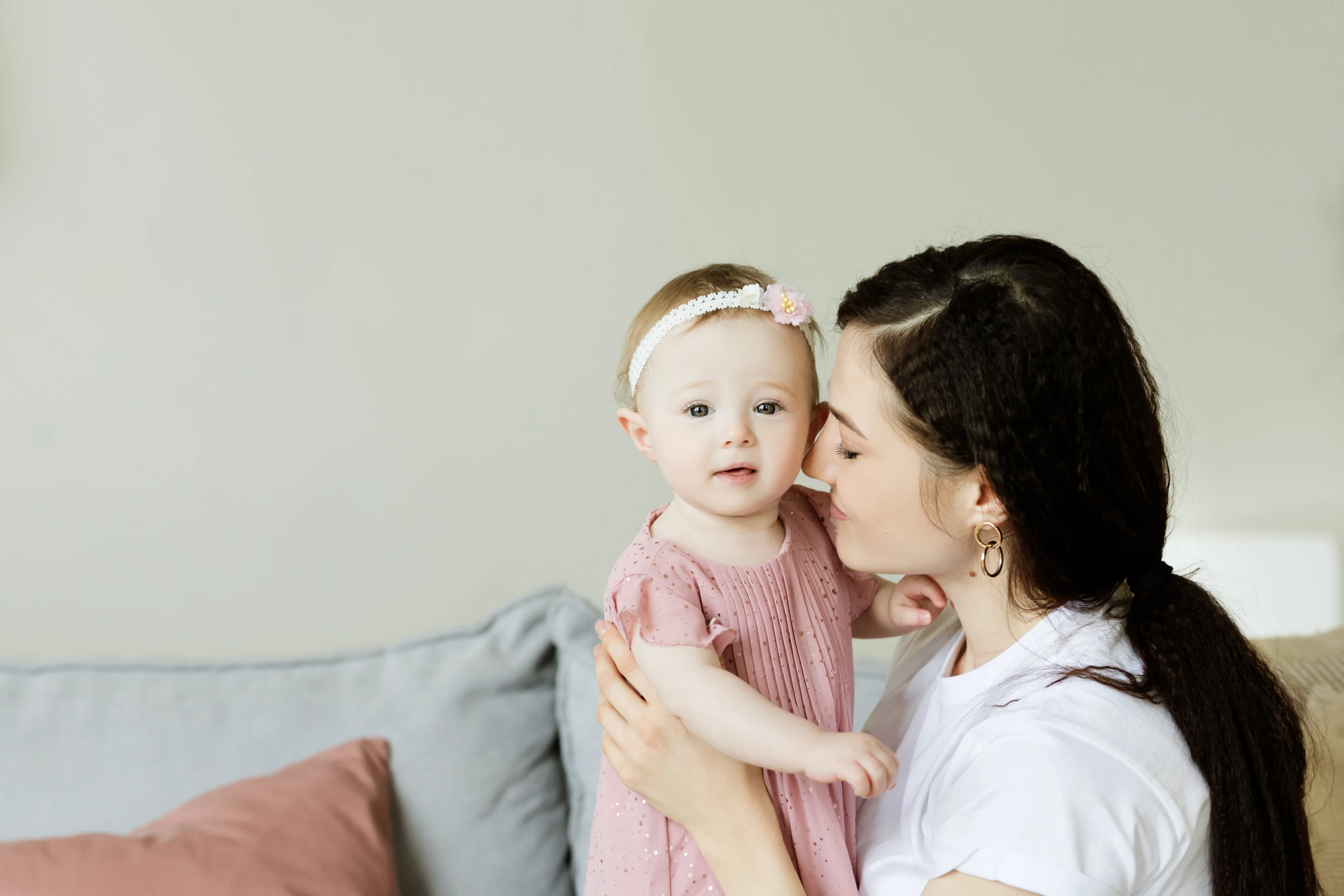
Baby classes are a growing trend, especially after the last few years of lockdowns. It’s amazing to think that so many new babies are starting with opportunities for brilliant social interactions. Parachute games are so much fun! They’re a popular feature of many baby classes, as they can be used with even the youngest babies. When used correctly, parachute activities can have countless benefits. Here are just a few:
Social Communication
Parachute games bring everyone together and are a great way to introduce your baby to interacting with others. During the parachute activities, make sure you make lots of lovely eye contact with your baby and give lots of smiles and reassuring sounds so that she knows that you are there with her and that this is something fun to do.
Watch your baby closely for signs that they want to communicate with you. They may start to copy your facial expressions and chuckle with delight.
Parachute games are a very social occasion, meaning your baby will begin to be aware of other babies around them. Often, in a baby class, when the parachute comes out, many babies start to communicate with one another through sounds and babble. This is brilliant, as it is the first sign of early communication and interaction and something to be celebrated.
Cognition and Early Learning
As you sing along and play during the parachute activities, your baby will be watching you closely and learning all kinds of new things. They will be listening to the rhythm and repetition in songs and nursery rhymes; they will be watching how your face moves as you sing; and they will be processing lots of early language. Even though they can’t talk themselves, you will be modeling all the information they need to learn. As you talk about different colors and shapes and introduce new words, your baby will be listening intently and learning from you.
Sensory Processing
Babies are very sensory. They are learning about the world around them through all of their senses, all of the time. When doing parachute activities, they will be using their sense of touch. As they grip and grasp the silky material, they will have plenty to look at to stimulate their sense of sight, like bright colors, and changes in the light as the parachute moves up and down. They will feel the breeze of the parachute on their faces and hear the whoosh of the material as it floats up and down. Parachutes are a sensory feast for a young baby.
Physical
Although your baby may not be mobile yet, the parachute will act as a brilliant stimulus for movement as it floats up and down and all around your baby. They may reach up to try and touch the parachute or kick their legs in response to it. Older babies may roll over or crawl in response to the parachute.
For more sensible advice on using a parachute with babies, visit this website.
Ready to play? Read on for lots of parachute games to get started:
Game 1: Wheels on the Bus
Lie your baby in the middle of the parachute with one or two other babies.
Parents should stand on the outside of the circle, take the handles, and slowly walk in a circle – move very slowly so that the babies don’t roll over onto one another. The babies should slowly turn around with you. Keep making lots of lovely eye contact and smiles. As you walk around, sing:
“The wheels on the bus go round and round,
Round and round, round and round,
The wheels on the bus go round and round,
All day long.”
Benefits: social time with other babies where the parents and baby are still within sight. Early language and communication skills.
Game 2: Rock-A-Bye
Lie your baby in the middle of the parachute next to the other babies, and let them feel and explore the silky material in their fists. Gently wrap some of the parachute around them, taking care not to cover their faces.
Sing:
Rock a bye baby on the tree top
When the wind blows the candle will rock
When the bough breaks the cradle will fall and
Down will come baby, cradle and all.
Look directly at your baby as you sing in a calm soothing voice.
Benefits: sensory touch, early language skills, social communication.
Game 3: Peep-Po
Adults should sit in a circle around the outside of the parachute with the other parents. Your baby should be on your knee facing the parachute. With one hand, the adults gently lift the parachute up and down. Say :
“One… Two… Three,
Look at me,
Peeeeep-Po”
When the parachute floats up, all look underneath it and say, “pee po,” to the babies underneath the parachute. Try to use lots of lovely anticipation to make your baby giggle with delight.
Benefits: Early play skills, early counting and social communication. Anticipation is a great way to encourage early speech.
Game 4: Row the Boat
As in the game above, the adults sit in a circle around the edges of the parachute with their babies on their knees so that they can see the other babies on their parents’ knees across the circle.
Put your hand gently over your baby’s hand and show them how to rock the parachute back and forth gently. Make sure the adults all tug the parachute in the same direction. As you rock back and forth, sing:
Row row, row your boat,
gently down the stream.
Merrily merrily merrily merrily,
Life is but a dream.
Benefits: Songs and rhymes, repetition, sensory touch, early communication.
Game 5: Bubbles

Stay in the same position as in the game above, with the adults gently pulling the parachute back and forth. On each movement, count one, two, three, four, five, and up. An adult should blow lots of bubbles into the middle of the parachute, and then on the count of five, everyone should gently lift it so that all the bubbles float upwards. Talk gently to your baby as the bubbles float up and then down again.
Benefits: Sensory perception, repetition of counting, early language development, anticipation, awe and wonder.
Game 6: Feathers
Just as in the game above, replace the bubbles with colorful feathers and as they float back down to earth, try to hold out your baby’s hand to touch them. You can also repeat this game with balloons.
Game 7: Five Little Monkeys
Adults sit in a circle with babies on their knees facing one another. One adult places 5 soft monkey toys in the middle of the parachute. Hold your baby and gently bounce the parachute up and down and sing:
5 little monkeys, jumping on the bed,
One fell off and bumped his head.
Mummy called the doctor and the doctor said..
No more monkey’s jumping on the bed.
4 little monkeys jumping on the bed…
Bounce the monkeys up and down, throwing one out every verse until there are none left. Use lots of expression and anticipation with your baby as you sing.
Benefits: Social communication, early counting, rhyme and repetition, anticipation and fun.
Game 8: Under the Sea
Once the babies have gotten used to the parachute, this game becomes a little more independent. It takes a little preparation but is worth the effort.
Tie long strips of green and blue paper or fabric around the outside of the parachute. Cut out fish shapes and use string to tie them to the underside of the parachute. Make sure they are well-spaced out.
Lay out lots of soft mats and place the babies on their backs. The adults gather the parachute and make a circle around the babies, lifting the parachute up and down like waves under the sea. A few adults should remain on their knees under the parachute with the babies so that they can be seen at all times. As the parachute “waves” go up and down, the strips of fabric and fish will move and sway.
Keep talking to your baby, making swishing noises and reassuring her. Play music, as adding some sensory music also works well.
Benefits: Sensory processing, hand-eye coordination, and early communication skills.
Game 9: Rainbow
Similar to the game above, prepare the parachute beforehand by attaching lots of colorful strips to it. You can use tissue paper, fabric strips, or sparkly wrapping paper—whatever you have to create a wavy, colorful world. Lay the babies on soft mats and the adults should hoist the parachute high over the babies. Make sure a few adults stay under the parachute with the babies in case anyone becomes overwhelmed. Hoist the parachute high, letting the rainbow ribbons sway just above the babies, and sing:
Red and yellow and pink and green,
orange and purple and blue,
I can sing a rainbow,
sing a rainbow,
sing a rainbow too.
Add bubbles and balloons to the experience.
Benefits: Sensory processing, early songs and rhymes, hand-eye coordination. Social communication.
Over-Stimulation

Most babies love to play parachute games, especially if their parents are there with them at the moment and they feel safe and contained. Please be aware that some babies can become overstimulated, so always be aware of the signs below. If you feel your baby is becoming overstimulated, take a little time out and give them some quiet time where they can be soothed.
Signs to be aware of:
A louder than usual cry.
Holding their arms up to you to be held.
Turning their head away from the parachute or from you.
Wanting to feed more frequently.
Clenching their fists or waving their arms and legs
Suddenly becoming very tired.
Self-soothing, for example, sucking their hands or fists.
If any of these signs happen, reassure your baby that you are still there and give lots of cuddles. You can always try again at a later time.
If you want further ideas for parachute play with children, try visiting this website.
Have fun with these parachute activities!
